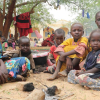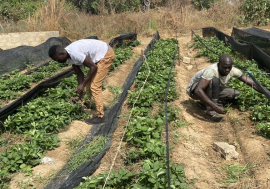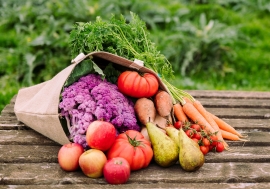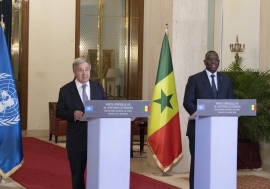Africa’s economy grows, but many stomachs are empty
Africa’s economy grows, but many stomachs are empty
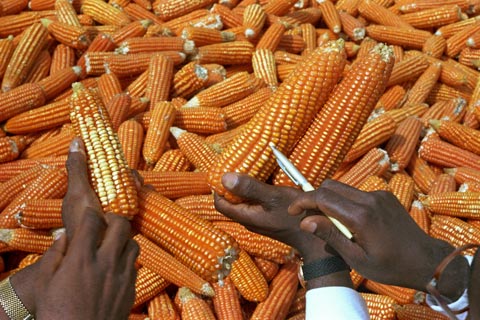 Examining high-quality corn for future cultivation in Cameroon: To reduce poverty and hunger, more investment is needed in agriculture.
Examining high-quality corn for future cultivation in Cameroon: To reduce poverty and hunger, more investment is needed in agriculture.Each year, governments, journalists, development experts and others look forward to the United Nations Development Programme’s Human Development Report. The report includes a ranking of countries based on life expectancy, literacy, quality of life and so on. Once it is released, governments and citizens of countries with high rankings immediately trumpet their achievements. Those with lower rankings, such as the Democratic Republic of the Congo, which was last in 2011, come in for criticism.
When UNDP announced it would launch its first-ever Africa Human Development Report in May, many expected that it would also include a general country ranking. Instead, the regional report focuses on the theme “Towards a food secure future,” with extensive analyses and recommendations on that topic. If the intention of the 190-page report was to generate debate on filling empty stomachs in Africa with nutritious food, that goal is being accomplished — probably beyond expectations.
Setting the tone
Helen Clark, UNDP administrator, and Tegegnework Gettu, director of the programme’s Africa bureau, set the tone in the opening pages. Ms. Clark writes: “It is my hope that this first Africa Human Development Report will energize a debate on how to strengthen food security … and lead to more decisive action.”
Mr. Gettu’s preface is a provocative clarion call on African leaders. “Africa is not fated to starve,” he writes. “That is an affront to both its dignity and its potential.... Africa must stop begging for food.... Had the African governments over the last 30 years met their people’s aspirations, the report would not be necessary. One quarter of the people in sub-Saharan Africa would not be undernourished, and one third of African children would not be stunted.”
Nigeria’s former President Olusegun Obasanjo echoed Mr. Gettu’s theme, calling the report “an indictment of African leadership in the area of food production. It tells us what we know: that the poverty of Africa is the making of African leaders over the years.”
During Asia’s green revolution, for example, many Asian countries spent up to 20 per cent of their budgets on agriculture, while African countries currently spend between 5 to 10 per cent on the sector. This is despite African leaders’ commitment in 2003 to allocate at least 10 per cent of national budgets to agriculture. The report notes that Africa spends more on the military than on agriculture.
Hunger amidst plenty
Launched in Nairobi, Kenya, and simultaneously in five other African countries (Zambia, Ghana, Ethiopia, Senegal and South Africa), the report further highlights what Mr. Gettu considers a harsh paradox of suffering amidst plenty. “Hunger and malnutrition remain pervasive on a continent with ample agricultural endowments,” he says. “Africa has the knowledge, the technology, and the means to end hunger and insecurity.”
The report raises an alarm over poverty in sub-Saharan Africa, calling the region the world’s most food insecure. Up to 25 per cent of sub-Saharan Africa’s 856 million people are undernourished, with 15 million people facing serious risks in the Sahel and an equal number in the Horn of Africa.
The worsening food situation in sub-Saharan Africa dampens glowing reports on Africa’s fast-growing economies, which have expanded by an annual average of 5 to 6 per cent during the past decade. However, notes Ms. Clark, “Impressive GDP growth rates in Africa have not translated into the elimination of hunger and malnutrition.”
At the Nairobi launch, Ms. Clark canvassed coordinated solutions. “Building a food-secure future for all Africans will only be achieved if efforts span the entire development agenda.” Without good roads, for example, surplus food cannot enter the market.
Important steps
The report lists steps that can be taken right away to stem the tide of food insecurity: “greater agricultural productivity of smallholder farmers; more effective nutrition policies, especially for children; greater community and household resilience to cope with shocks; and wider popular participation and empowerment, especially of women and the rural poor.”
Many African leaders are already picking up on various aspects of the report. Africa’s first elected female president, Ellen Johnson-Sirleaf of Liberia, considers the role of women in food security “profound and critical.” According to President Johnson-Sirleaf, better education and access to food assets such as land, capital and labour will likely increase productivity by 20 per cent. The report urges countries to “end decades of bias against agriculture and women,” because women’s education can lower malnutrition in children more than does an increase in household income. Compared with other regions, African women have the least access to land.
Kenyan President Mwai Kibaki, who co-launched the report in Nairobi, linked nutritious food to mental and physical wellbeing, stressing that “it also enables people to exercise their freedoms and capabilities in different fields.” Kenya is rated as a high-risk food-insecure country. President Kibaki attributed this to the impact of drought in the past five years, although Kenya’s agricultural sector has been revived from a negative growth of 2.3 per cent in 2009 to a positive 6.3 per cent by 2010.
Opinion is unanimous that climate change will have a negative impact on agriculture. “Africa is most susceptible to variations in agro-climate,” maintains Ethiopian Prime Minister Meles Zenawi, who notes that “climate change exacerbates the problem of food insecurity.” In addition, the report explains that the semi-arid region from Senegal to Chad and the Horn of Africa, particularly Djibouti, Ethiopia, Kenya and Somalia, have all been affected by severe climate conditions.
While acknowledging the impact of drought on food security, the report notes that famines often get the headlines, even though uneven access to food due to low incomes is as much a problem. “The silent crises of chronic malnourishment and seasonal hunger do not receive nearly enough attention.” It adds that increased agricultural production does not necessarily guarantee food security unless there are improvements in access to health, better roads, more job opportunities and empowerment of women.
Bright spots
Notwithstanding the deplorable food situation in sub-Saharan Africa, there are many bright spots, including Mr. Obasanjo’s Nigeria, where the government’s Agricultural Transformation Agenda is expected to ensure food sufficiency and create 3.5 million jobs by 2015. Ghana has already halved poverty by boosting cocoa farmers, becoming the first sub-Saharan country to achieve the first Millennium Development Goal, which is to reduce by half the proportion of people living in poverty and hunger by 2015.
Malawi undertook a huge seed and fertilizer subsidy programme and turned its food deficit into a 1.3 million tonne surplus in just two years. In Senegal child malnutrition was lowered from 34 to 20 per cent between 1990 and 2005 through increased national agricultural budgets. By increasing agriculture’s budget from 1.6 per cent in 2008 to 7.7 per cent in 2009, Sierra Leone grew 784,000 tonnes of rice, above the domestic requirement of 550,000 tonnes.
As the continent posts world-beating economic growth rates, it needs to move faster to fill empty stomachs with nutritious food. If it achieves that goal, then the release of UNDP’s first Africa Human Development Report may be seen as an important contribution to that effort.
—Africa Renewal online





